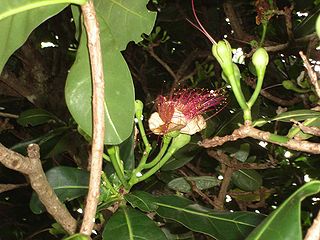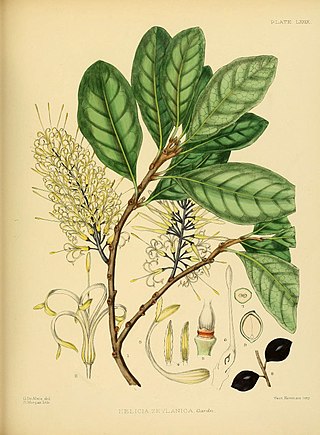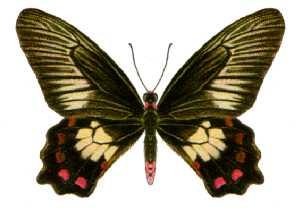
Cordyline is a genus of about 24 species of woody monocotyledonous flowering plants in family Asparagaceae, subfamily Lomandroideae. The subfamily has previously been treated as a separate family Laxmanniaceae, or Lomandraceae. Other authors have placed the genus in the Agavaceae. Cordyline is native to the western Pacific Ocean region, from New Zealand, eastern Australia, southeastern Asia and Polynesia, with one species found in southeastern South America.

Barringtonia is a genus of flowering plants in the family Lecythidaceae first described as a genus with this name in 1775. It is native to Africa, southern Asia, Australia, and various islands of the Pacific and Indian Oceans. The genus name commemorates Daines Barrington.

Orania is a genus of the palm tree family Arecaceae, whose native is Madagascar, Malesia, and New Guinea.

Buchanania is a genus of plants in the family Anacardiaceae and subfamily Anacardioideae.

Helicia is a genus of 110 species of trees and shrubs, constituting part of the plant family Proteaceae. They grow naturally in rainforests throughout tropical South and Southeast Asia, including India, Sri Lanka, Indochina, Peninsular Malaysia to New Guinea and as far south as New South Wales.
Aristolochia ceropegioides, synonym Pararistolochia ceropegioides, is a plant species of family Aristolochiaceae. It is found in Cameroon and Gabon. Its natural habitats are subtropical or tropical dry forests and subtropical or tropical moist lowland forests. It is threatened by habitat loss.
Pararistolochia is a formerly accepted genus in the plant family Aristolochiaceae. As of March 2023, it is considered a synonym of the genus Aristolochia.

Aristolochia goldieana is a species of plant in the family Aristolochiaceae. It is found in Benin, Cameroon, Ghana, Guinea, Guinea-Bissau, the Gulf of Guinea Islands, Ivory Coast, Liberia, Nigeria, and Sierra Leone. Its natural habitat is subtropical or tropical moist lowland forests. It is threatened by habitat loss.
Aristolochia preussii, synonym Pararistolochia preussii, is a species of plant in the family Aristolochiaceae. It is native to Cameroon, Equatorial Guinea, Gabon, and Ivory Coast. Its natural habitat is subtropical or tropical dry forests. It was assessed as "critically endangered" and threatened by habitat loss in the 2000 IUCN Red List, where it is said to be native only to Cameroon., Plants of the World Online gives it a wider distribution.

Zygogynum is a genus of plant in the winter's bark family Winteraceae. 19 species are native to New Caledonia, and are pollinated primarily by beetles and moths. Other species are native to New Guinea, the Bismarck Archipelago, the Solomon Islands, Lord Howe Island, and Queensland.

Papua New Guinea–United States relations refers to the diplomatic relations between Papua New Guinea and the United States of America. The two countries established diplomatic relations following Papua New Guinea's independence on September 16, 1975. The two nations belong to a variety of regional organizations, including the Asia-Pacific Economic Cooperation (APEC) forum; the ASEAN Regional Forum (ARF); the Pacific Community (SPC); and the South Pacific Regional Environmental Program (SPREP).

Talipariti is a genus of plants in the mallow family Malvaceae. It consists of 22 species, which are exclusively tropical except for one species whose range extends into temperate areas of Japan and Korea. Most authors now treat these species as part of the genus Hibiscus, in which case they form the section Hibiscus sect. Azanzae.

Pararistolochia australopithecurus, synonym Pararistolochia australopithecurus, is an Australian plant in the Aristolochiaceae or birthwort family, native to Queensland. It is a rainforest vine and the host plant for the Cairns birdwing butterfly and the red-bodied swallowtail. Found in the area around Mount Bellenden Ker of north Queensland. Between the Little Mulgrave River and the South Johnstone River.

Pachliopta polydorus, the red-bodied swallowtail, is a butterfly from the family Papilionidae found in north-eastern Queensland, Australia and Papua New Guinea.
Airosperma is a genus of flowering plants in the family Rubiaceae. It was described by Karl Moritz Schumann and Carl Adolf Georg Lauterbach in 1900. It contains 6 accepted species, all endemic either to New Guinea or to Fiji.
Canarium vitiense is a rainforest tree species, of the plant family Burseraceae, growing naturally in Fiji, the Solomon Islands, Samoa, Tonga, New Guinea, Bismarck Archipelago, Admiralty Islands, Louisiade Archipelago, Torres Strait Islands and in lowland north-eastern Queensland, Australia.
Pleuranthodium is a genus of plants in the ginger family. Of the 23 known species, 21 are endemic to New Guinea, one to Queensland and one to the Bismarck Archipelago.

Pararistolochia enricoi is an endemic Malagasy species of plant in the birthwort family, the only belonging to the genus Pararistolochia within the Island.
A tree in the Moraceae family, Ficus phaeosyce grows in eastern New Guinea, endemic to the nation of Papua Niugini. It is a shade tolerant understorey species, locally very abundant. A range of insect herbivores feed on the plant.
A tree in the Anacardiaceae family, Buchanania macrocarpa is native to an area in the southwest Pacific from the Solomon Islands to the northern Maluku Islands.











